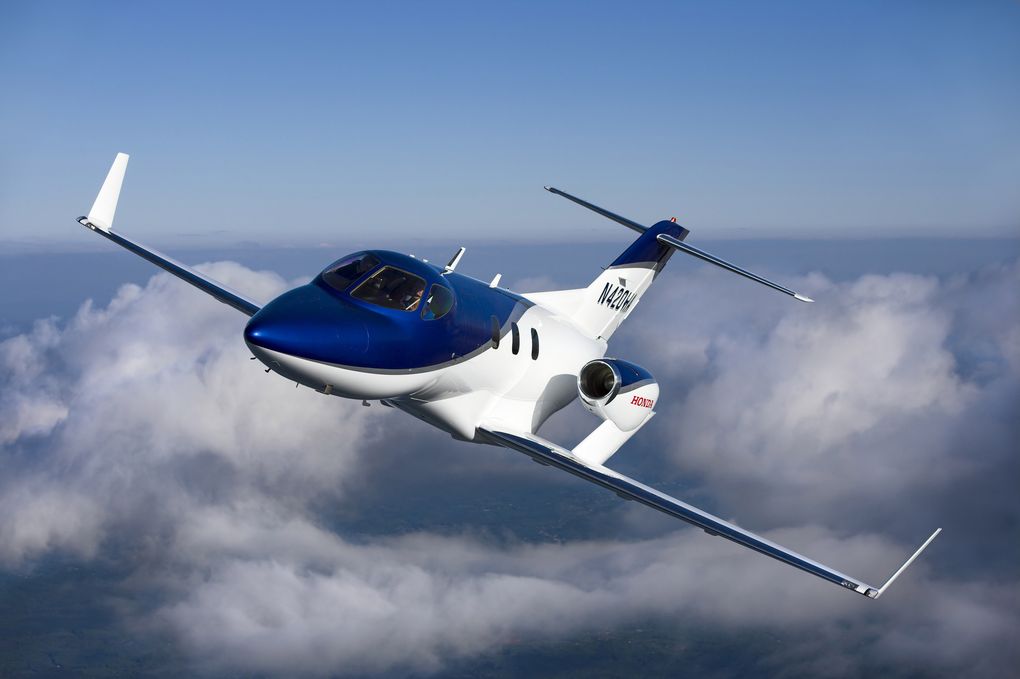Sci-Tech Information: Honda Is Making a Luxury Jet With Really Weird Engines
To most, Honda is a maker of the everycar €” affordable, safe, practical, fuel efficient road transportation that neither excites nor offends. To some, it’s also a maker of motorcycles. To a few, it’s the maker of Asimo, the perennially entertaining humanoid robot that makes appearances at trade shows.
No one would peg Honda as a maker of futuristic jet aircraft, though.
The Japanese auto giant has been quietly researching small jets since the late 1980s, debuting the HondaJet as a multimillion-dollar experiment over a decade ago in 2003. The six-passenger bullet cruises at 420 knots €” about 0.63 Mach €” and gets power from a pair of specially designed turbofans developed through a joint venture with General Electric.
What makes the HondaJet really unusual, though (besides the fact that it’s being made by the same company that makes the Civic) is a unique engine mount that gives the plane its trademark appearance. Where most jets of this size have engines mounted on either side of the rear of the fuselage, the HondaJet’s HF120 turbofans rest on pedestals that rise from the wings. The advantage, Honda notes, is that the configuration frees up significant additional space inside the cabin. As a bonus, it also just looks downright sci-fi.
Honda just announced this week that the first production HondaJet is now in final assembly. The road to this point hasn’t been an easy one €” the high-tech transport has been beset with delays, most recently due to an engine failure during testing €” but the company says it’s tracking for FAA certification in the first quarter of 2015.
Start saving your pennies: the aircraft will command around $4.5 million when it goes on sale.
Honda launches new robot with more human-like features
Move over, R2D2. Honda’s updated robot is bound to be the best companion one will ever want at home. Want to welcome visitors at home? Not a worry, as it can shake hands with anyone and open a bottle and serve a drink afterwards which makes it perfect for your home parties. But the newly revised ASIMO is more than just your average robot.
Short for Advanced Step in Innovative Mobility, Honda’s humanoid robot is intended to support people with limited mobility. Initially launched in 2000, it took developers 14 years to copy and emulate real human movements for its robot. This year’s version, aside from its white suit and helmet reminiscent of an astronaut headed to space, have added features such as jumping and running at a maximum speed of 5.6 miles per hour. Not only that, it is also equipped to do sign language for people who have reduced hearing.
While it may be fun to have one at home, just think about the numerous things you will be able to accomplish with this smart robot. Honda developers are keener on targeting the elderly for the helper robot. €Asimo was designed to help those in society who need assistance, and Honda believes that these improvements in ASIMO bring us another step closer to our ultimate goal of being able to help all kinds of people in need,€ according to senior chief engineer Satoshi Shigemi. He added that they will continue working to understand what people want ASIMO to do, indicating there will even be more updates in the future.
Honda, Toyota aim to sell fuel cell vehicles to consumer market in 2015
As car manufacturers shift to eco-friendly vehicles, Japan’s Honda and Toyota are thinking of introducing their fuel cell automobiles to the consumer market next year. Both firms are looking at producing around 1,000 units each of their eco-cars, which boast of longer ranges than the electric cars in the market, with zero emissions, annually after bringing them to the consumer market.
To gradually introduce the vehicle adoption rate, both firms are offering them on a for-lease basis, targeting businesses and municipalities as users. Prices will be initially set below 10 million yen (about US$98,000) to encourage potential buyers. Honda plans to present its 5-passenger sedan it is currently developing by November next year. The car will have a carbon fiber hydrogen tank that allows it to travel 500 kilometers on a single charge, twice the capability of an electric vehicle. The firm is looking at manufacturing 5,000 units in a period of five years at their Sayama plant in Saitama, with target markets in the U.S., Europe and Japan. As the company collaborated with General Motors in developing fuel cell mechanisms last year, they plan to incorporate the technologies in the car next year.
Toyota on the other hand, will produce their eco-car at their plant in the prefecture of Aichi, with the objective of producing such units past tens of thousands by 2020. In Toyota’s model, the hydrogen tanks have been divided into two and the power-generating system was made more compact and situated under the seats for more legroom and space. The company is now conducting road tests to check the reliability of their fuel cell vehicles. As both car firms have low production outlooks, capital spending may be limited and prices, specifically for Toyota vehicles, may be slashed by 3 to 5 million yen in 2020.
